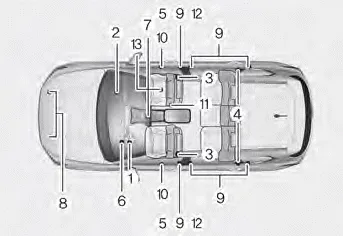Hyundai Santa Fe (TM): Air bag - supplemental restraint system / How does the air bags system operate?

The SRS consists of the following components:
(1) Driver's front air bag module
(2) Passenger's front air bag module
(3) Side air bag modules
(4) Curtain air bag modules
(5) Retractor pre-tensioner
(6) Air bag warning light
(7) SRS control module (SRSCM)/ Rollover sensor
(8) Front impact sensors
(9) Side impact sensors
(10) Side pressure sensors
(11) Seat belt buckle sensor
(12) Emergency fastening device system
(13) Occupant classification system
The SRSCM continually monitors all SRS components while the ignition switch is ON to determine if a crash impact is severe enough to require air bag deployment or pre-tensioner seat belt deployment.
SRS warning light

The SRS (Supplemental Restraint System) air bag warning light on the instrument panel displays the air bag symbol depicted in the illustration. The system checks the air bag electrical system for malfunctions. The light indicates that there is a potential problem with your air bag system, which could include your side and/or curtain air bags used for rollover protection (if equipped with rollover sensor).
WARNING
If your SRS malfunctions, the air bag may not inflate properly during an accident, increasing the risk of serious injury or death.
If any of the following conditions occur, your SRS is malfunctioning:
- The light does not turn on for approximately three to six seconds when the Engine Start/Stop button is in the ON position.
- The light stays on after illuminating for approximately three to six seconds.
- The light comes on while the vehicle is in motion.
- The light blinks when the engine is running.
- Have an authorized HYUNDAI dealer inspect the SRS as soon as possible if any of these conditions occur.
During a moderate to severe frontal collision, sensors will detect the vehicle’s rapid deceleration. If the rate of deceleration is high enough, the control unit will inflate the front air bags, at the time and with the force needed.
The front air bags help protect the driver and front passenger by responding to frontal impacts in which seat belts alone cannot provide adequate restraint. When needed, the side air bags help provide protection in the event of a side impact or rollover by supporting the side upper body area.
- Air bags are activated (able to inflate if necessary) only when the Engine Start/Stop button is in the ON or START position, and it can be activated within about 3 minutes after the engine is turned off.
- Air bags inflate in the event of certain frontal or side collisions to help protect the occupants from serious physical injury.
- There is no single speed at which the air bags will inflate. Generally, air bags are designed to inflate based upon the severity of a collision and its direction. These two factors determine whether the sensors produce an electronic deployment/inflation signal.
- The front air bags will completely inflate and deflate in an instant. It is virtually impossible for you to see the air bags inflate during an accident. It is much more likely that you will simply see the deflated air bags hanging out of their storage compartments after the collision.
- In addition to inflating in serious side collisions, vehicles equipped with a rollover sensor, side and/or curtain air bags will inflate if the sensing system detects a rollover. When a rollover is detected, curtain air bags will remain inflated longer to help provide protection from ejection, especially when used in conjunction with the seat belts. (if equipped with a rollover sensor)
- To help provide protection, the air bags must inflate rapidly. The
speed of air bag inflation is a consequence of extremely short time in which
to inflate the air bag between the occupant and the vehicle structures before
the occupant impacts those structures. This speed of inflation reduces the risk
of serious or lifethreatening injuries and is thus a necessary part of air bag
design. However, the rapid air bag inflation can also cause injuries which can
include facial abrasions, bruises and broken bones because the inflation speed
also causes the air bags to expand with a great deal of force.
Driver’s and passenger’s front air bags Your vehicle is equipped with a Supplemental Restraint System (SRS) and lap/shoulder belts at both the driver and passenger seating positions.
After a frontal or side air bag inflates, it will deflate very quickly. Air bag inflation will not prevent the driver from seeing out of the windshield or being able to steer.
Other information:
Hyundai Santa Fe (TM) 2019-2023 Service and Repair Manual: Receiver-Drier. Repair procedures
Replacement 1. Using a Lwrench, remove the cap (A) on the bottom of the receiver-drier. 2. Remove the receiver-drier (A) from condenser using a long nose plier. Check for crumbled receiver-drier and clogged bottom cap filter.
Hyundai Santa Fe (TM) 2019-2023 Service and Repair Manual: Controller
Heater & A/C Control Unit (Manual). Components and components location Component Connector Pin Function Pin No Connector A Connector B 1 Battery Low 2 ISG B+ Common 3
Categories
- Manuals Home
- Hyundai Santa Fe Owners Manual
- Hyundai Santa Fe Service Manual
- Driver assistance system
- Advanced Driver Assistance System (ADAS)
- Heating,Ventilation And Air Conditioning
- New on site
- Most important about car
